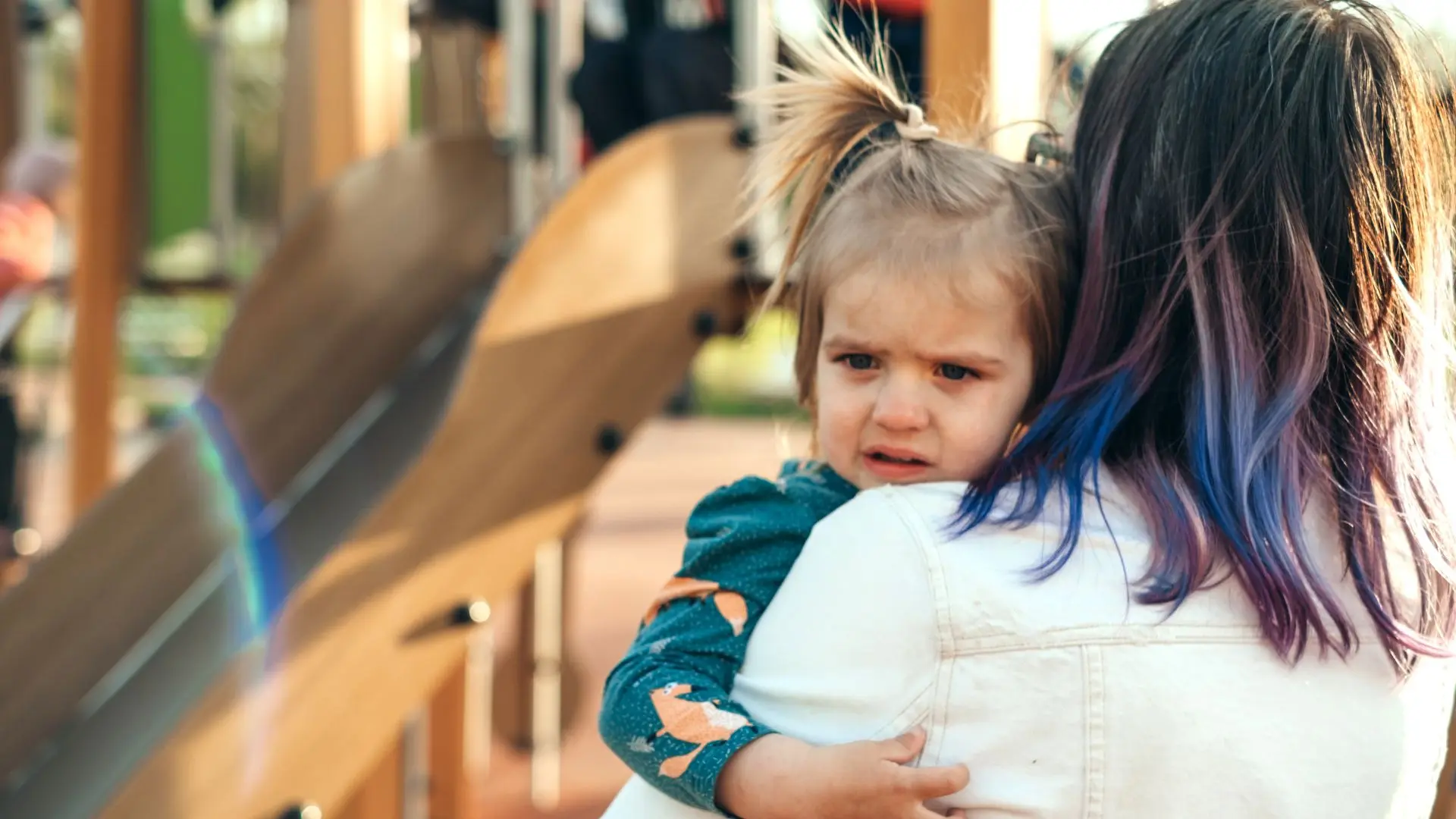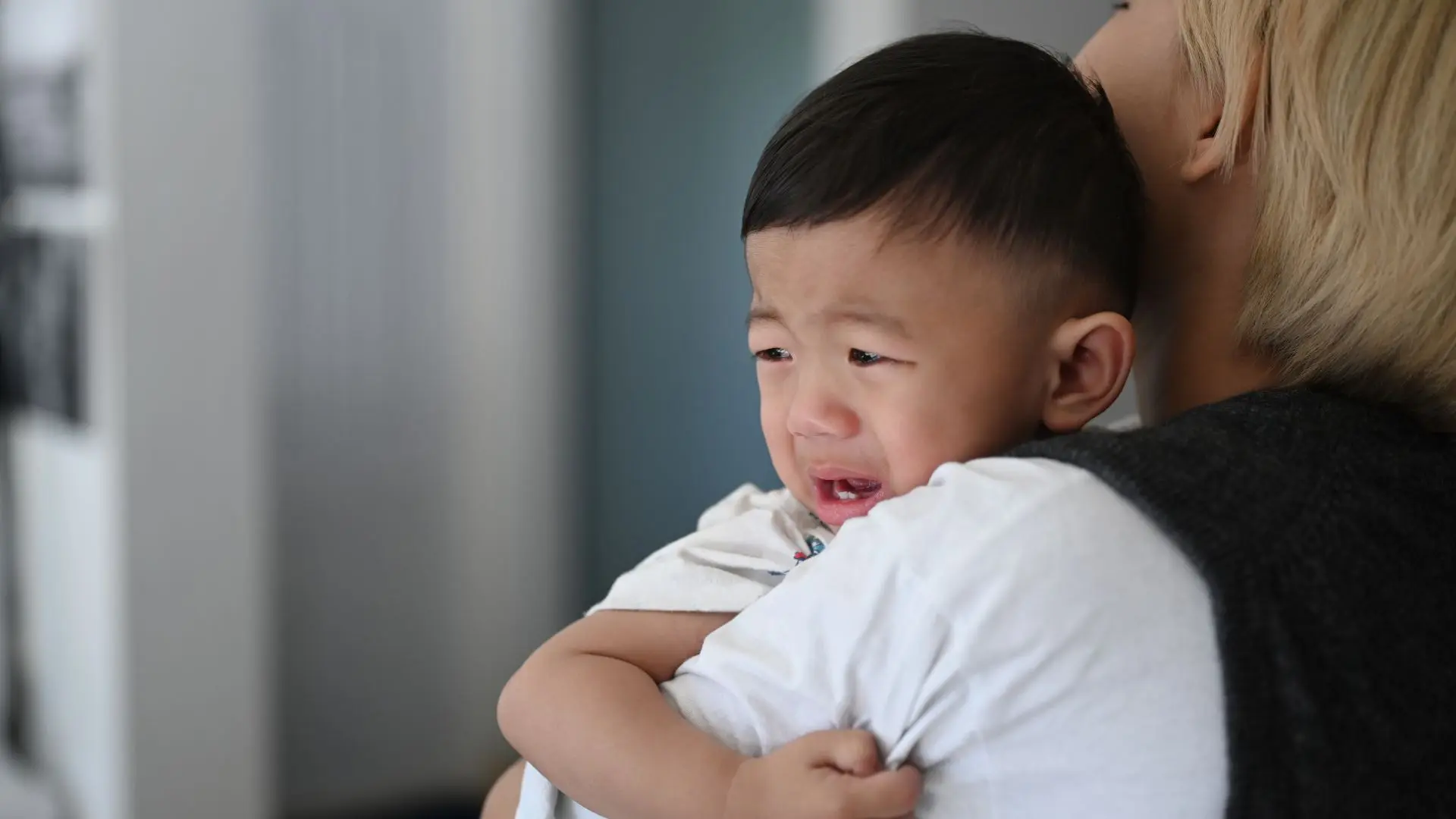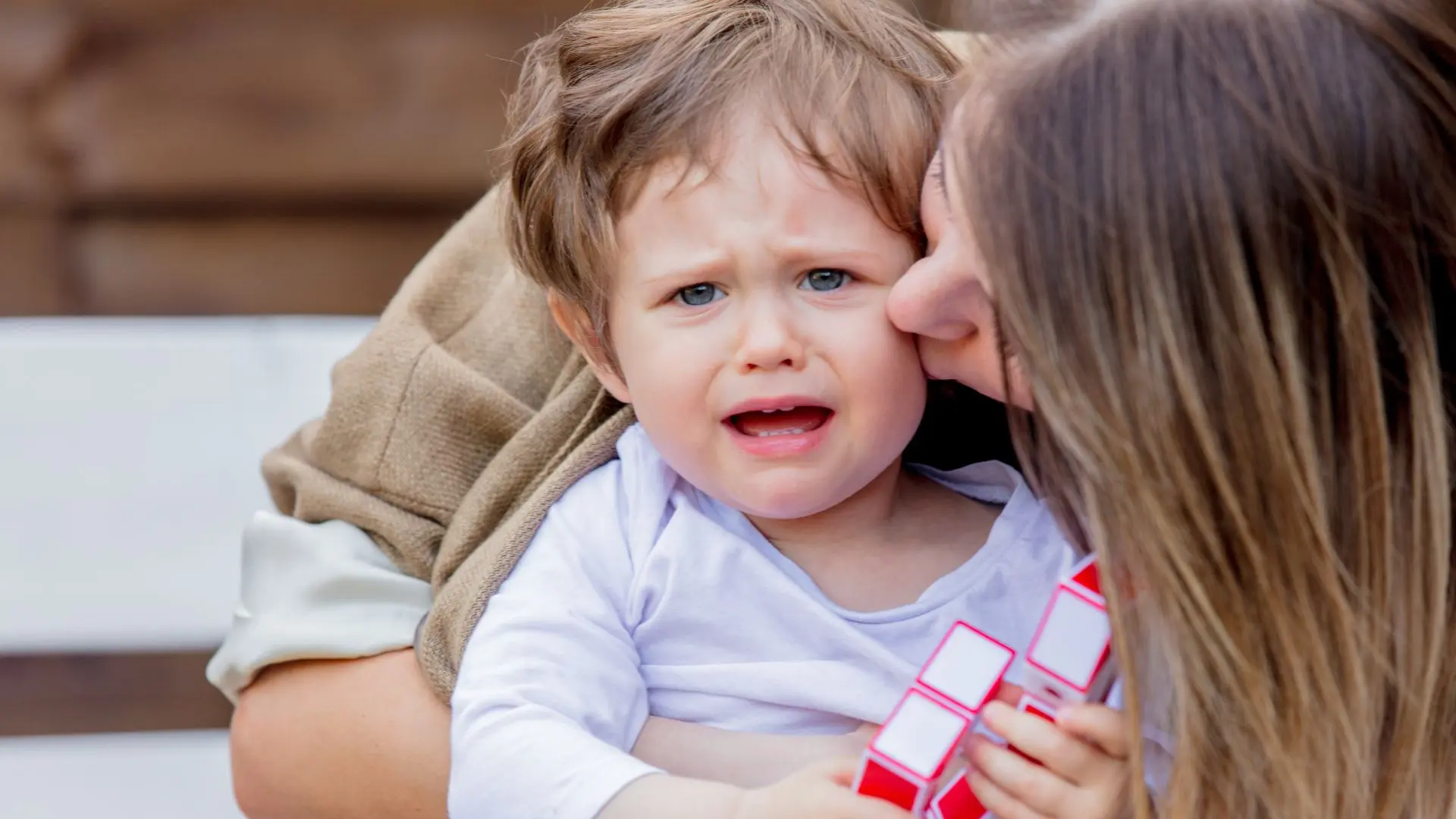Learn how to support your child through separation anxiety. Our blog covers essential information on signs, causes, and effective strategies for parents.

Whether it’s tears at daycare drop-off or clinging during bedtime, separation anxiety is a normal part of growing up—though it can feel overwhelming for both you and your child.
Understanding what drives this anxiety, and how to ease it, can make all the difference in navigating this phase with confidence and reassurance. Let’s explore the causes, signs, and most effective strategies to help your child (and you) cope with separation anxiety.
What Is Separation Anxiety?
Separation anxiety is a normal developmental phase in children aged 0 to 5, where they experience distress when separated from their primary caregivers. It typically begins around 6 months and peaks between 8 to 9 months, highlighting the strong emotional bonds they form with their parents. While it can be challenging for both parents and children, it’s a natural part of growing up.
Signs and Symptoms of Separation Anxiety
Recognizing the signs of separation anxiety can help you understand your child’s behavior and emotions better. Here are some:
Behavioral Signs
- Clinginess: Your child may cling to you, refusing to let go when you try to leave.
- Crying: This is one of the most visible signs of separation anxiety. You might witness tears or screaming when you leave.
- Tantrums: Tantrums can escalate when your child senses a separation is about to occur.
Emotional Signs
- Fearfulness: Your child may express fears about being alone or worry about your safety when you’re apart.
- Nervousness: They might become easily agitated or show signs of distress in new environments or around unfamiliar people.
Physical Symptoms
- Complaints of Aches: Sometimes, children may complain of stomachaches or headaches as a physical manifestation of their anxiety.
- Sleep Disturbances: Separation anxiety can lead to difficulties with sleep, including nightmares or trouble falling asleep.
Separation Anxiety in Different Age Groups
Separation anxiety manifests differently at various developmental stages. Understanding these differences can help you provide the right support at the right time.
Infants (0-12 Months)
During the first year of life, your baby begins forming attachments. At this stage, separation anxiety is normal and often peaks around eight to nine months. You may notice your baby crying when you leave the room or becoming fussy around unfamiliar people. They are learning that you are a reliable source of comfort and security, which is vital for their emotional development.
Toddlers (1-3 Years)
As children grow into toddlers, they begin to understand more about the world and their place in it. This stage often brings a peak in separation anxiety as toddlers become more aware of their surroundings. They may cry or cling to you when it’s time to say goodbye, especially in new situations like daycare.
Preschoolers (3-5 Years)
As children reach preschool age, their understanding of time and distance evolves. They may start to express fears about being apart from you or might worry about what could happen while you’re away. This anxiety can become more pronounced in new environments or during significant life changes, such as moving or starting school.
Causes of Separation Anxiety
Let’s see some of the primary causes of separation anxiety and how they impact your child.

1. Developmental Milestones
One of the main causes of separation anxiety is the child’s natural development. Around six to eight months, babies begin to develop what’s known as object permanence, the understanding that people and objects continue to exist even when they can’t be seen. Before this milestone, out of sight truly means out of mind for babies. But once they grasp that concept, they become more aware when you’re not in their immediate presence, which can trigger separation anxiety. This developmental phase is completely normal and a sign that your child’s cognitive abilities are advancing.
2. Attachment to Primary Caregivers
Children form strong emotional bonds, known as attachment, with their primary caregivers, usually parents. This secure attachment provides them with a sense of safety and comfort. However, when a child is separated from their primary caregiver, even temporarily, it can create a sense of fear and vulnerability. The closer and more consistent this attachment, the more intense the separation anxiety can be. This is not a bad thing— it shows that the child has formed a strong and healthy bond, but it can still lead to difficulties during periods of separation.
3. Changes in Routine or Environment
Sudden changes in a child’s routine or environment can also trigger separation anxiety. For example, starting daycare, a new babysitter, moving to a new home, or even a family vacation that disrupts the daily routine can heighten anxiety. Children thrive on predictability, and when their sense of stability is challenged, they might react by becoming more anxious when separated from their caregiver. These disruptions can cause separation anxiety to flare, especially in toddlers who are just beginning to understand the importance of consistency in their world.
4. Parental Stress or Anxiety
Children are incredibly perceptive and often mirror the emotions of their parents. If a parent is visibly anxious or stressed about a separation, such as dropping the child off at school or daycare, the child may pick up on those feelings and experience increased separation anxiety. It’s essential for parents to remain calm and confident during separations to help ease their child’s anxiety. Your emotional state can play a significant role in how your child perceives the separation.
5. Traumatic Events
A child who has experienced a traumatic event, such as the loss of a loved one, illness, or divorce, may develop or worsen their separation anxiety. Traumatic events can cause children to become more fearful of being separated from their caregivers, as they may associate the separation with the potential for something bad to happen. In these cases, separation anxiety may be more intense and long-lasting, requiring more sensitive handling and, in some cases, professional support.
6. Personality and Temperament
Some children are naturally more prone to separation anxiety due to their personality or temperament. Children who are more sensitive, shy, or introverted might struggle more with being apart from their caregivers. These children may need extra reassurance and gradual exposure to new experiences to feel more comfortable with separation. Their temperament makes them more likely to become anxious in unfamiliar situations, which often intensifies separation anxiety.
7. Overprotective Parenting
In some cases, overprotective parenting can contribute to the development or worsening of separation anxiety. When parents are overly cautious or prevent their children from having independent experiences, the child may become more dependent on them. This dependency can make separations more difficult because the child hasn’t had the chance to develop confidence in navigating the world without their caregiver. Striking a balance between providing security and encouraging independence is essential in reducing separation anxiety.
8. Sibling Influence
If a child has older siblings who also display signs of separation anxiety, they may mimic this behavior. Children learn a lot by observing those around them, particularly family members. If they see a sibling becoming upset or anxious during separations, they may also develop similar anxieties. On the other hand, positive sibling experiences with separations can help ease a younger child’s fears.
9. Limited Socialization
Children who haven’t had many opportunities to interact with others or who have been mostly homebound may experience heightened separation anxiety. Socialization helps children become comfortable being around others and teaches them that they can thrive even when their caregiver isn’t present. Without these experiences, children may struggle with separation anxiety because they haven’t had the chance to develop trust in other adults or feel confident in new environments.
How to Ease Separation Anxiety
While it’s completely normal for children to experience separation anxiety, there are several strategies you can use to help ease their feelings and make separations smoother for everyone involved.

1. Establish a Predictable Routine
Children thrive on routine because it provides them with a sense of security and control. A predictable daily schedule helps reduce separation anxiety because the child knows what to expect and when. If your child knows that after lunch, it’s time for a nap, or after breakfast, it’s time for daycare, the sense of predictability can reduce their anxiety about the upcoming separation.
- Create a Morning Routine: Establishing a consistent morning routine before leaving for daycare or school can make transitions smoother. Involving your child in the process—whether it’s getting dressed, brushing their teeth, or packing their bag—can also help them feel more in control and prepared.
- Stick to Consistent Drop-Offs: If possible, have the same parent or caregiver handle drop-offs, and do it at the same time each day. This consistency helps minimize uncertainty.
2. Create a Goodbye Ritual
Goodbye rituals can provide comfort and predictability to your child, helping ease their anxiety when it’s time to part ways. A goodbye ritual should be simple and reassuring, allowing your child to know that while you’re leaving now, you’ll be back soon.
- Special Hug or Handshake: Develop a special way to say goodbye, such as a hug, high-five, or special handshake that your child looks forward to. Keep it short and sweet.
- Reassuring Phrase: You might say something like, “I’ll see you after lunch” or “I’ll be back before dinner.” This creates a clear expectation in your child’s mind about when you’ll return, helping reduce uncertainty.
3. Practice Short Separations
One of the most effective ways to overcome separation anxiety is by gradually increasing your child’s comfort with being away from you. Start with brief separations and gradually extend them over time.
- Start Small: Leave your child with a trusted caregiver for a short period, such as 15-20 minutes, then gradually increase the duration as they become more comfortable.
- Frequent Departures: Regular, brief separations help your child understand that you’ll always return, which reduces anxiety over time.
4. Use Transitional Objects
A transitional object, like a favorite toy, blanket, or even a photo of you, can provide comfort to a child struggling with separation anxiety. These objects serve as a reminder of home and of you, helping the child feel more secure when you’re not around.
- Favorite Toy or Blanket: Let your child bring their favorite stuffed animal or blanket with them when they go to daycare or a relative’s house. Familiarity with the item can provide reassurance.
- Wearable Reminder: Some parents give their child a small item to carry, such as a piece of their clothing or a charm, reminding them that you’re always close by.
5. Encourage Independence
Fostering independence in your child can help reduce separation anxiety by boosting their confidence in navigating the world without you. Encouraging independent activities, whether at home or in social settings, helps your child learn that they can handle time apart.
- Playtime Alone: Encourage your child to play independently for short periods while you remain nearby. Over time, extend these periods to help build their confidence.
- Structured Activities: Enroll your child in structured activities like group classes or playdates where they’ll need to engage with other children and adults without your constant presence. This helps them develop the social and coping skills needed to manage separations.
6. Prepare Them for the Separation
Talking to your child about upcoming separations ahead of time can help reduce separation anxiety. By preparing them for what’s going to happen, you reduce the shock and fear of the unknown.
- Talk About the Day’s Plans: Let your child know what will happen during the day. For example, “First, we’re going to daycare, then you’ll have snack time, and I’ll pick you up after your nap.” This helps create a mental timeline for your child.
- Practice Before Big Events: If your child is starting school or daycare, practice short drop-offs in advance so they know what to expect. A few trial runs can make the actual separation much easier.
7. Be Calm and Confident During Goodbyes
Children take emotional cues from their parents, so if you’re anxious or upset when leaving, your child is likely to mirror those feelings. Try to stay calm, confident, and upbeat during goodbyes, even if it’s difficult.
- Quick and Positive Goodbyes: While it’s tempting to linger, prolonged goodbyes often make separation anxiety worse. A quick, cheerful goodbye followed by your departure gives your child the message that leaving is no big deal and that you trust them to be okay.
- Avoid Sneaking Away: While it might seem easier to slip out unnoticed, sneaking away can make separation anxiety worse because your child may feel abandoned or betrayed when they notice you’re gone. Always say goodbye, even if it’s tough.
8. Encourage Socialization
Children who regularly interact with peers and adults outside their immediate family often feel more comfortable being away from their parents. Encouraging social interactions can help ease separation anxiety by showing your child that they can enjoy themselves without you being present.
- Playdates: Arrange regular playdates with other children to help your child build relationships outside of the family. These experiences teach your child that they can have fun and be safe even when you’re not there.
- Group Activities: Join local parenting or child playgroups, where your child can engage in activities with others in a structured environment. Socialization in a group setting provides reassurance that being apart from you is a normal part of life.
9. Be Consistent
Consistency is key when it comes to overcoming separation anxiety. Having consistent routines, consistent people involved in drop-offs, and predictable departures and returns will help your child feel more secure.
- Same Drop-Off Routine: If possible, try to have the same person drop off and pick up your child every day. Familiarity provides comfort and reduces anxiety about separations.
- Regular Caregivers: When leaving your child with babysitters or daycare, aim to have the same caregivers as often as possible. Trust and familiarity with caregivers can greatly reduce separation anxiety.
10. Be Patient and Reassuring
Overcoming separation anxiety is a gradual process, and it’s important to be patient with your child. Offer them reassurance that their feelings are valid and that you’ll always return.
- Acknowledge Their Feelings: Let your child know that it’s okay to feel scared or sad when you leave. Acknowledge their emotions and reassure them that these feelings will get easier over time.
- Positive Reinforcement: Praise your child when they handle separations well, even if it’s just a small step forward. Positive reinforcement can encourage them to keep progressing.
When to Seek Professional Help
While separation anxiety is a normal part of development, there are instances where it may require additional support.
If your child’s anxiety persists beyond the typical age range or significantly interferes with their daily life, it may be time to seek professional help. Signs that you might consider consulting a professional include:
- Inability to attend school or participate in social activities due to anxiety.
- Physical symptoms (e.g., stomachaches or headaches) that occur regularly when facing separations.
- Nightmares or sleep disturbances related to separation.
If you find yourself in this situation, consider consulting a child psychologist for tailored assessments and interventions. Joining a parent support group can also provide valuable emotional support and practical advice.
Conclusion
Separation anxiety is a natural and essential part of your child’s emotional development, even though it can feel challenging in the moment. By understanding the root causes and recognizing the signs, you can better support your child through this phase. Remember, your calm and consistent approach will help them feel secure, even when you’re apart.
As your child grows, their anxiety will ease with time, patience, and gentle encouragement. Embrace this opportunity to foster their independence while providing the reassurance they need. With the right strategies, both you and your child will navigate separations with greater confidence and resilience.
You may also be interested in : 20 Nutritious Toddlers Dinner Ideas for Picky Eaters